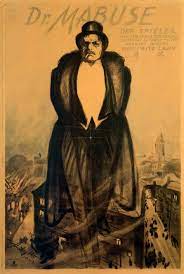
Dr. Mabuse (Rudolf Klein-Rogge) is a sociopathic narcissist, which makes him the perfect master criminal. He is also a psychoanalyst, and a master of disguise. In addition he is adept in mind control and hypnosis. With these gifts Mabuse undertakes various criminal enterprises. One is to frequent gambling establishments and mentally induce rich gamblers to lose until they are in debt for thousands of marks. Since he wears a different disguise each time, no one knows what he really looks like. To facilitate his various schemes he employs several minions and henchmen. One of them is a dancer named Cara Carozza (Aud Egede-Nissen). Carozza is in love with Mabuse but she is only a means to an end for him. He uses her to manipulate his victims.
Mabuse comes to the attention of State Prosecutor Norbert von Wenk (Bernhard Goetzke) when Mabuse, with Carozza’s help, uses a young socialite named Edgar Hull (Paul Richter) as his next victim and fleeces the industrialist to where he secures an IOU of 150,000 marks from him. Wenk’s problem is that he doesn’t know Mabuse’s real name or what he looks like. When Mabuse realizes that Hull is working with the State Prosecutor he decides they both have to be eliminated. Hull ends up dead and Carozza ends up in jail.
Mabuse meets the Countess Dusy Told (Gertrude Welcker) at a séance. He manipulates an invitation to her home. He falls in love with the Countess and induces her husband, Count Told (Alfred Abel) to cheat at cards and get caught. He then kidnaps the countess. Count Told is now a broken man and suffering from depression. Unaware that Mabuse kidnapped the Countess he believes she left him because of his cheating at cards and fled to her mother’s. Not knowing what to do, he contacts Dr. Mabuse for treatment. Mabuse uses the opportunity to make the Count worse. He keeps the Count cut off from the world. The clinically depressed Count begins to hallucinate. When the Countess rejects Mabuse the hypnotist talks the Count into killing himself.
Getting rid of loose ends he also has one of his minions talk Carozza into taking poison while in jail so she doesn’t talk. Mabuse tries to get rid of Wenk by having his office bombed. The bomber is caught and ends up another loose end to be disposed of. With Wenk still hounding him, Mabuse is beginning to feel the strain. His continuing use of mind control is taking a toll on him. He begins to make mistakes.
“Dr. Mabuse the Gambler” AKA “Dr. Mabuse der Spieler” was released in 1922 and was directed by Fritz Lang. It is the first film in the Dr. Mabuse series and was based on the character created by Norbert Jacques. It is a German silent film. The movie is four and a half hours long and is divided into two parts. Part 1: “The Great Gambler: A Picture of the Time” is 2 hours and 34 minutes long. Part 2: “Inferno: A Game for the People of our Age” is 1 hour and 54 minutes long. The two parts were released a month apart.
The film was released four years after the close of WWI. Because of this the film is often looked at as a social commentary of Germany and its problems during the period after the war where Germany was devastated paying war reparations. Many racists look at Mabuse as the ultimate Jewish figure, even though it is not an anti-Semitic film. Others look at it as a precursor to Hitler and the Nazi dystopia. Still others look at Mabuse as Nietzsche’s Superman.
It is a long movie. Because of that a lot of people got bored with it. Those that have a love of German Expressionistic films and or Fritz Lang loved it. I liked it for the Mabuse character and Rudolf Klein-Rogge’s acting skills as well as the fantastic expressionistic sets. The Told house is great example of how a set can enhance a film as if it was a character in the film. The bizarre furnishings in the house are at first strange when Wenk and the Countess are looking at the Count’s collections. Later when the Count is isolated from the world, and his wife is gone, the house morphs into a dark and foreboding place. You get the impression that only the dead haunt it.
The screenplay was written by Thea von Harbou. At the time she was married to Rudolf Klein-Rogge. This is also when Thea and Lang began an affair. Eventually Thea and Klein-Rogge would divorce and Thea would marry Lang. The divorce was amicable and never impacted the film.

